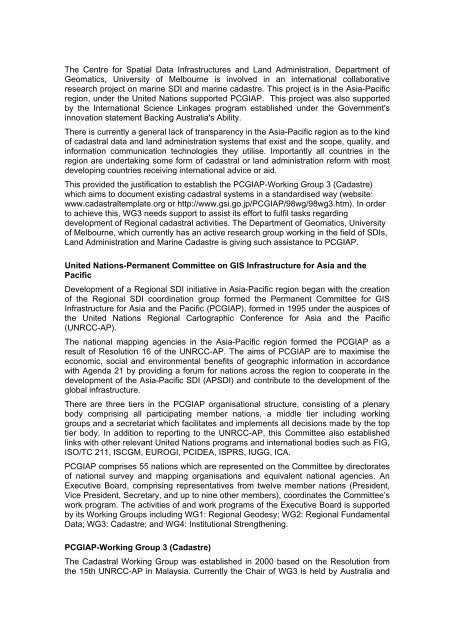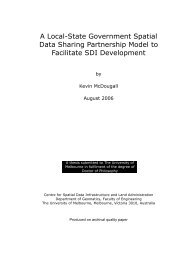Marine Cadastres - Challenges and Opportunities for Land Surveyors
Marine Cadastres - Challenges and Opportunities for Land Surveyors
Marine Cadastres - Challenges and Opportunities for Land Surveyors
You also want an ePaper? Increase the reach of your titles
YUMPU automatically turns print PDFs into web optimized ePapers that Google loves.
The Centre <strong>for</strong> Spatial Data Infrastructures <strong>and</strong> L<strong>and</strong> Administration, Department of<br />
Geomatics, University of Melbourne is involved in an international collaborative<br />
research project on marine SDI <strong>and</strong> marine cadastre. This project is in the Asia-Pacific<br />
region, under the United Nations supported PCGIAP. This project was also supported<br />
by the International Science Linkages program established under the Government's<br />
innovation statement Backing Australia's Ability.<br />
There is currently a general lack of transparency in the Asia-Pacific region as to the kind<br />
of cadastral data <strong>and</strong> l<strong>and</strong> administration systems that exist <strong>and</strong> the scope, quality, <strong>and</strong><br />
in<strong>for</strong>mation communication technologies they utilise. Importantly all countries in the<br />
region are undertaking some <strong>for</strong>m of cadastral or l<strong>and</strong> administration re<strong>for</strong>m with most<br />
developing countries receiving international advice or aid.<br />
This provided the justification to establish the PCGIAP-Working Group 3 (Cadastre)<br />
which aims to document existing cadastral systems in a st<strong>and</strong>ardised way (website:<br />
www.cadastraltemplate.org or http://www.gsi.go.jp/PCGIAP/98wg/98wg3.htm). In order<br />
to achieve this, WG3 needs support to assist its ef<strong>for</strong>t to fulfil tasks regarding<br />
development of Regional cadastral activities. The Department of Geomatics, University<br />
of Melbourne, which currently has an active research group working in the field of SDIs,<br />
L<strong>and</strong> Administration <strong>and</strong> <strong>Marine</strong> Cadastre is giving such assistance to PCGIAP.<br />
United Nations-Permanent Committee on GIS Infrastructure <strong>for</strong> Asia <strong>and</strong> the<br />
Pacific<br />
Development of a Regional SDI initiative in Asia-Pacific region began with the creation<br />
of the Regional SDI coordination group <strong>for</strong>med the Permanent Committee <strong>for</strong> GIS<br />
Infrastructure <strong>for</strong> Asia <strong>and</strong> the Pacific (PCGIAP), <strong>for</strong>med in 1995 under the auspices of<br />
the United Nations Regional Cartographic Conference <strong>for</strong> Asia <strong>and</strong> the Pacific<br />
(UNRCC-AP).<br />
The national mapping agencies in the Asia-Pacific region <strong>for</strong>med the PCGIAP as a<br />
result of Resolution 16 of the UNRCC-AP. The aims of PCGIAP are to maximise the<br />
economic, social <strong>and</strong> environmental benefits of geographic in<strong>for</strong>mation in accordance<br />
with Agenda 21 by providing a <strong>for</strong>um <strong>for</strong> nations across the region to cooperate in the<br />
development of the Asia-Pacific SDI (APSDI) <strong>and</strong> contribute to the development of the<br />
global infrastructure.<br />
There are three tiers in the PCGIAP organisational structure, consisting of a plenary<br />
body comprising all participating member nations, a middle tier including working<br />
groups <strong>and</strong> a secretariat which facilitates <strong>and</strong> implements all decisions made by the top<br />
tier body. In addition to reporting to the UNRCC-AP, this Committee also established<br />
links with other relevant United Nations programs <strong>and</strong> international bodies such as FIG,<br />
ISO/TC 211, ISCGM, EUROGI, PCIDEA, ISPRS, IUGG, ICA.<br />
PCGIAP comprises 55 nations which are represented on the Committee by directorates<br />
of national survey <strong>and</strong> mapping organisations <strong>and</strong> equivalent national agencies. An<br />
Executive Board, comprising representatives from twelve member nations (President,<br />
Vice President, Secretary, <strong>and</strong> up to nine other members), coordinates the Committee’s<br />
work program. The activities of <strong>and</strong> work programs of the Executive Board is supported<br />
by its Working Groups including WG1: Regional Geodesy; WG2: Regional Fundamental<br />
Data; WG3: Cadastre; <strong>and</strong> WG4: Institutional Strengthening.<br />
PCGIAP-Working Group 3 (Cadastre)<br />
The Cadastral Working Group was established in 2000 based on the Resolution from<br />
the 15th UNRCC-AP in Malaysia. Currently the Chair of WG3 is held by Australia <strong>and</strong>







